The main goal of this session is to prepare a team set up in a 4-3-3 system to beat an opponent playing in a 4-4-2 diamond system, through a specific building up game plan. After a deep analysis about how teams use a diamond formation to defend in a medium block, the drills have been designed to counteract the strengths and to better attack the weaknesses that this formation has.

| Area | Up to full pitch |
| Equipment | Balls, bibs, cones, 2 full size goals |
| No. of Players | 20 players + 2 goalkeepers |
| Session Time |
Warm-up: 20mins, Removing the diamond: 10mins, Midfielder drops deep: 8mins, 10v10 possession game: 16mins |
The main goal of this session is to prepare a team set up in a 4-3-3 system to beat an opponent playing in a 4-4-2 diamond system, through a specific building up game plan.
After a deep analysis about how teams use a diamond formation to defend in a medium block, the drills have been designed to counteract the strengths and to better attack the weaknesses that this formation has.
It is really interesting to apply into the practice ideas that come from previous analysis of the game. The 4-4-2 diamond system is a variation of the classic 4-4-2 formation but there are differences that increase the strengths. There are many advantages, especially in attacking phases. However, no formation is perfect and as coaches we have to provide our players with the best clues possible for them to find the way to damage the opponents’ system during the match.
I selected this session because it’s a good example of one of our main goals as coaches – how to transfer to the training sessions and to our players, the ideas that come from the game analysis in order to help to achieve good results.
This kind of session’s structure and drills are designed to be used during weeks when we play against a team with a clear and well defined 4-4-2 diamond system. Usually it is one of the main training sessions in the middle of the week, in which a specific preparation to face an opponent is needed.
The activities have high tactical, technical and physical demands, so this session can be used to achieve a general development of the player. Also, during the pre-season it is possible to run this type of session to create a higher number of tactical solutions to be developed during the season in relation to the different opponent systems that we have to face.
REMOVING THE DIAMOND BLOCK
The drills that are presented here are a result of previous game analysis focusing on how teams with a central diamond defend when they press from a medium block. If our team has good possession and moves the ball quickly flank to flank to increase the tempo and speed of the game in a building up phase, the diamond midfielders have to increase their workload to cover the width of the pitch.
If the diamond keeps narrow to avoid passes with our offensive midfielder, the overlap options through the wings can appear, creating a favourable
overload situation for us. However, if the central midfielders pull wide to cover the flank, we can find spaces in the middle of the pitch to progress forward.
If we master both options, we will have real chances to beat the defensive block of a team with a 4-4-2 diamond system and to create solid goal scoring chances.
We set up a playing area on two thirds of a pitch with a goal and a goalkeeper at one end. The blues represent our opponents and are set up in a 4-4-2 system with a midfield diamond. We are coaching the reds who are attacking the only goal and who are set up in a 4-3-3 system.
In the first example, play starts with the left back passing across the back line. This draws the blue left midfielder out of position to press the red right back, as shown [1a], leaving space behind for the reds to pass into midfield and progress through the midfield towards goal.
1a
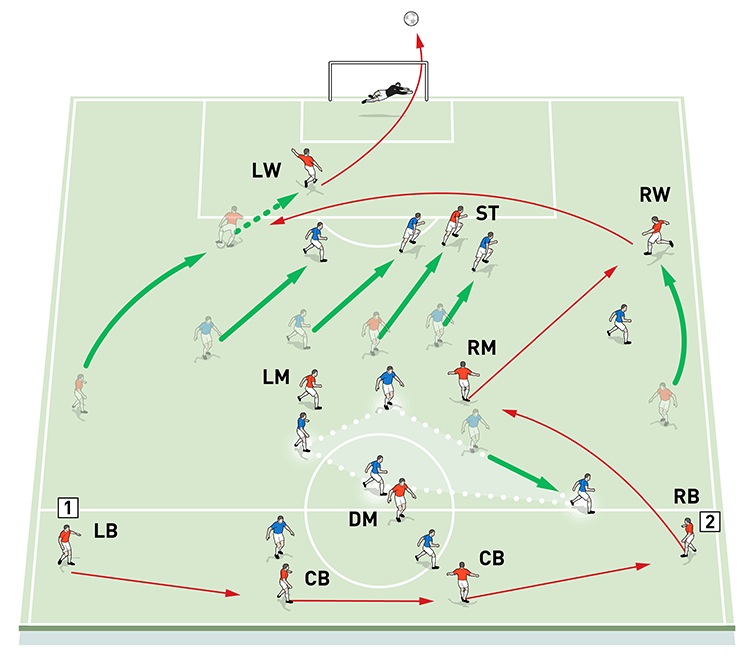
2. The blue left midfielder is drawn out of position to press the red right back leaving space behind for the reds to pass into midfield
In the second example, play again starts with the left back passing across the back line but if the blue defending left midfielder stays to mark the red right midfielder and doesn’t press the red right back, then the right back now has enough time and the space to drive into and moves up the wing, as shown [1b].
1b.

2. The blue defending left midfielder stays to mark the red right midfielder and doesn’t press the red right back
3. The red right back now has time and space to drive into and can move up the wing
In the third example, play again starts with the left back passing across the back line, but if the blue diamond midfield moves across, then the block moves down the wing and the red right back can switch play to the opposite wing where the diamond midfield has left space, as shown [1c].
1c
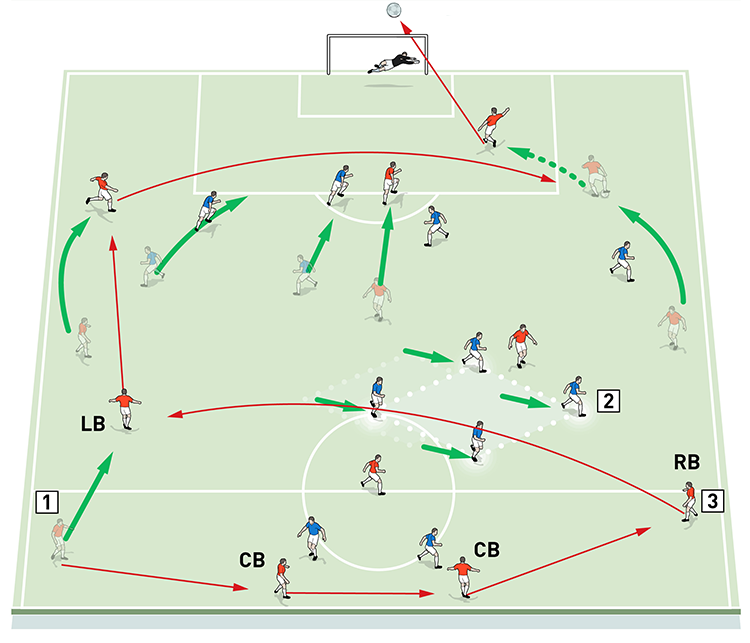
2. If the blue diamond midfield moves across, then the block moves down the wing
3. The red right back can now switch play to the opposite wing where the blue diamond midfield has left space
MIDFIELDER DROPS DEEP
In these drills, the reds are still aiming to beat the blue diamond block and they do so with a midfielder dropping deep. Play again starts in both examples with the left back passing across the back line but this time the red right back moves higher up the pitch and the red right midfielder drops into the space. If the blue midfielder stays to mark the red right back, it means the red right midfielder can receive deep from the centre back and surge into space to set up an attack through midfield, as shown [2a].
2a
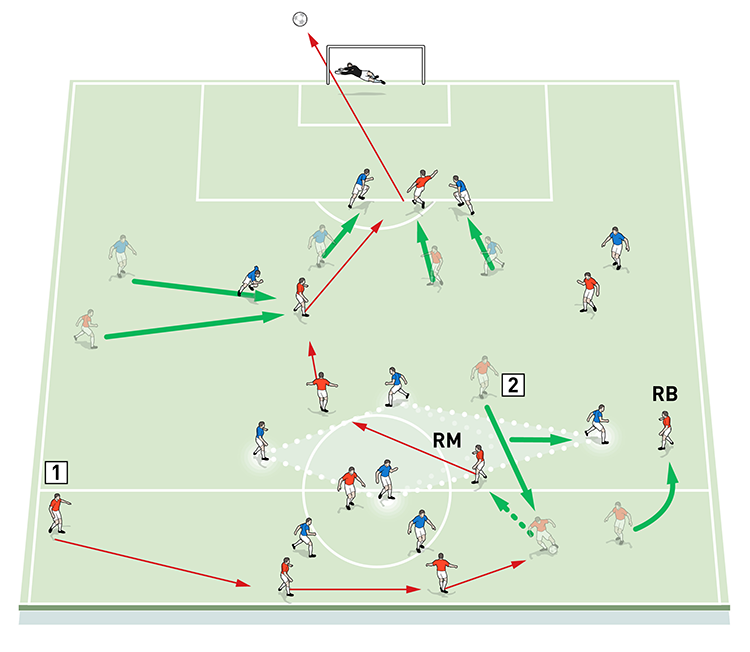
2. The red right midfielder drops into the space. If the blue midfielder goes to mark the right back, the red right midfielder can receive from the centre back and surge into the space to launch an attack
However, if the blue midfielder goes to press the red right midfielder who has dropped, it leaves the red right back open and play can go through him up the wing, as shown [2b].
2b
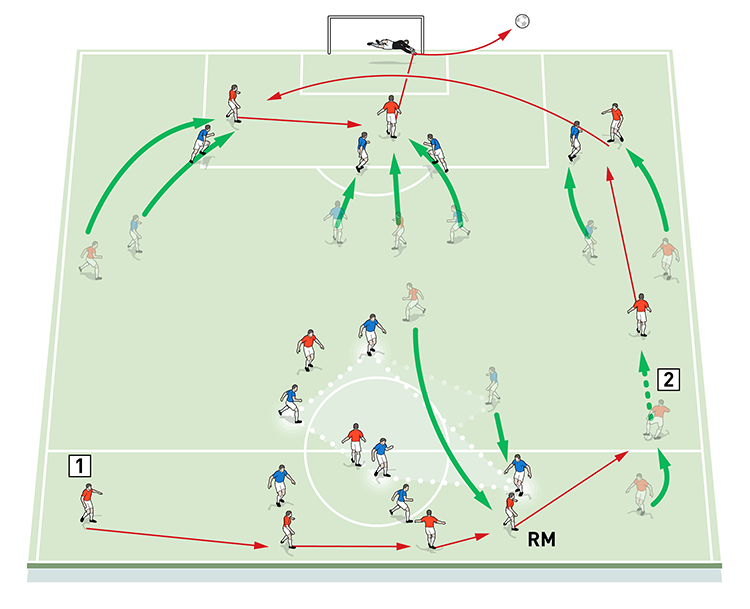
2. If the blue midfielder goes to press the red right midfielder who has dropped, it leaves the red right back open and play can go through him up the wing
10v10 POSSESSION GAME
We set up between the 18-yard line at one end and the byline at the other end, with a goal and a goalkeeper at each end. We mark a 40x30-yard central game area around the centre circle. We’re using 20 outfield players split into two teams of ten.
We are coaching the red attacking team who are set up in a 4-3-3 formation. The blue defensive team set up in a 4-4-2 diamond formation.
The game goes live in the central square, with a pass from the red left back to the centre back. When the reds have possession, in order to attack the goal and pass line A they have to make a double flank to flank passing sequence before progressing. That means transferring the ball from wing A to wing B and then back to wing A before they can break through line A to attack, as shown [3a]. But the right and left wings can only be used by three attackers at a time, if they need to keep the possession.
3a
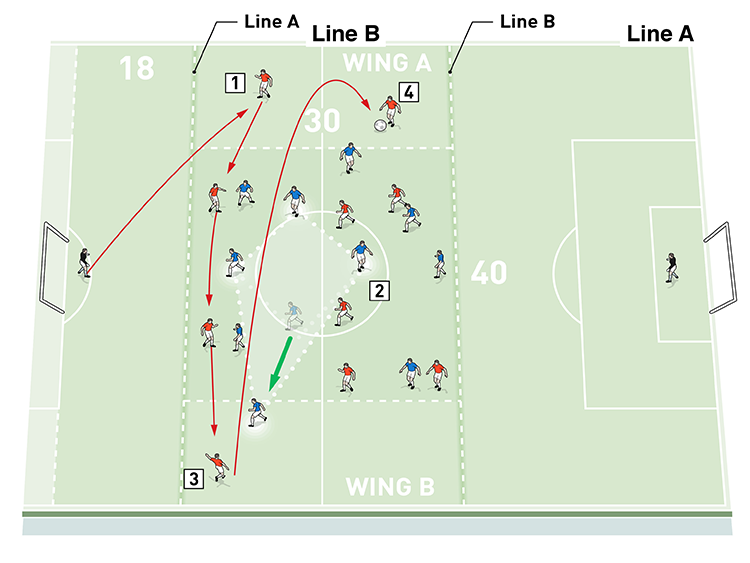
2. The blue defensive team uses a 4-4-2 diamond formation
3. Before being allowed to pass line A and attack the goal, the reds have to make a double flank to flank passing sequence. That means transferring the ball from wing A to wing B and then back to wing A
4. The right and left wings can only be used for three attackers at a time if they need to keep the possession
When the reds cross line A, only the two blue centre backs can recover past this line to defend. All the reds can attack the goal to create a heavy overload, as shown [3b].
3b

2. Only the two blue centre backs can recover past line A to defend, allowing the reds a big overload
3. If the blues gain possession, they have to transition to attack quickly
If the blues gain possession, they have to attack quickly. The transition is easier for the blues because the goal they are attacking is at the short end of the pitch, only 18 yards from the central square, which increases the difficulty for the reds to get back and defend.
COACHING POINTS
What are the key things to look out for?
There are a few things that the players have to understand in order to master the session and know what’s needed for the game plan.
Firstly, we want to see players moving the ball quickly around the pitch from side to side, to increase the tempo in order to move the defensive block of the opponent.
Secondly, players should keep a wide positioning; both fullbacks and both wingers should be open in the beginning of the attacking phase. It is critical to create doubt in the right or left midfielder of the opposition diamond about who has to defend and also make opposition midfielders use extra effort when are trying to cover the width of the pitch.
Also, it’s important that we see the ability to alternate the two different offensive positioning options: flank to flank with the final pass to the full back, keeping our midfielder in the middle; and flank to flank with a pass to our midfielder, who drops deep to be part of the first building up line.
If the team masters both situations, the doubt in the opposing team to defend will increase, knowing that we can find spaces to progress on the opposite side if they slide too much to cover the flank, or we can outnumber the opposition on the same wing if they are too narrow.
What are the typical mistakes players might make and how do I avoid them?
In the possession drill, as the players have unlimited touches to keep the possession, sometimes this rule decreases the fast tempo of the play and is easy to defend against.
The players have to understand that if they move the ball quickly around the pitch to increase the tempo of the game, using few touches and switching the play from flank to flank as fast as they can, the demand and the workload of the diamond to cover the width of the pitch will be higher, disorder in the opposition’s defensive block will appear and we will find more spaces to progress and damage the opponent.
To remedy this problem, we would restrict the players on the red attacking team to two touches in the central game area and leave it as unlimited touches on the wings.
Editor's Picks
Attacking transitions
Deep runs in the final third
Using the goalkeeper in build-up play
Intensive boxes drill with goals
Penetrating the final third
Creating and finishing
My philosophy
Pressing initiation
Compact team movement
Coaches' Testimonials

Alan Pardew

Arsène Wenger

Brendan Rodgers

Carlos Carvalhal

José Mourinho

Jürgen Klopp

Pep Guardiola

Roy Hodgson

Sir Alex Ferguson

Steven Gerrard
Coaches' Testimonials

Gerald Kearney, Downtown Las Vegas Soccer Club

Paul Butler, Florida, USA

Rick Shields, Springboro, USA

Tony Green, Pierrefonds Titans, Quebec, Canada
Join the world's leading coaches and managers and discover for yourself one of the best kept secrets in coaching. No other training tool on the planet is written or read by the calibre of names you’ll find in Elite Soccer.
In a recent survey 92% of subscribers said Elite Soccer makes them more confident, 89% said it makes them a more effective coach and 91% said it makes them more inspired.
Get Monthly Inspiration
All the latest techniques and approaches
Since 2010 Elite Soccer has given subscribers exclusive insight into the training ground practices of the world’s best coaches. Published in partnership with the League Managers Association we have unparalleled access to the leading lights in the English leagues, as well as a host of international managers.
Elite Soccer exclusively features sessions written by the coaches themselves. There are no observed sessions and no sessions “in the style of”, just first-hand advice delivered direct to you from the coach.








